Nikon AF-S 14-24mm f/2.8G ED NIKKOR
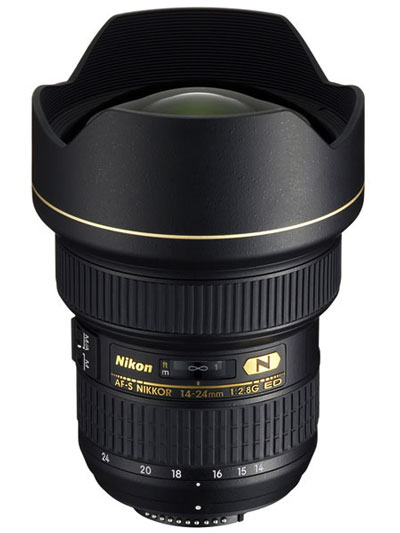 |  Nikon's fast aperture super-wide zoom lens gets the ePHOTOzine treatment from expert Gary Wolstenholme |
Nikon AF-S 14-24mm f/2.8G ED NIKKOR: Features and handling
Nikon's 14-24mm f/2.8 extreme-wide zoom lens is a professional optic truly deserving the extreme title. 14mm is very, very wide on a full-frame camera lending itself to use for landscapes, interiors and up-close and personal photojournalism right in the thick of the action. Nikon's latest technologies have been employed in the manufacture of this lens including their Nano-Crystal coat, which promises to reduce ghosting and flare, ED glass to reduce chromatic aberrations and Nikon's Silent Wave focusing motor, for fast and silent AF and full-time manual override.
To achieve such a wide field of view, this lens has a huge bulbous front element within a permanent petal-shaped metal hood. A large push-on lens cap is supplied which fits over the metal hood. I found this better than the sock-type hoods sometimes supplied with large diameter lenses as it is much easier to remove and replace. Those who have never used or seen such a lens before may be a bit nervous of damaging the protruding glass element, and those who use filters extensively may be dismayed by their inability to use them with this lens. Personally these quirks don't bother me. I love the way the lens balances on my D700, with or without the MB-D10 grip attached.
Although the overall length of the lens doesn't change during zooming, the front element retracts towards 24mm, so the front element sticks out the most at 14mm. Focusing is performed internally and it's very fast, as is typical for wide lenses.
Most of the body of the 14-24mm is constructed of metal, similar to other current professional Nikkors and as a result it feels very solid indeed. The zoom ring moves with quite a light touch, which is quite an achievement considering the sheer amount of glass being moved around by the zoom mechanism. I really enjoyed using this lens for its handling, as well as the wild wide-angle effects that can be achieved.
Nikon AF-S 14-24mm f/2.8G ED NIKKOR: Performance
For this review, the lens was tested on a 12Mp Nikon D700 using Imatest.
Wide open at 14mm, this lens is already a very good performer producing images with very good centre sharpness and only ever so slightly softer corners. Stop down just one stop to f/4 and the lens is at its peak for centre sharpness, with corner sharpness approaching excellent. By f/8 the excellent resolution is uniform across the frame. This aperture gives the best resolution and corner sharpness before diffraction takes hold reducing resolution across the image field. Even though the effect of diffraction is quite strong, as it typically is for this kind of extreme wide-angle, the resolution at f/22 is still good and won't cause too many issues for most.
As the lens is zoomed in, the same resolution characteristics are displayed, albeit at slightly reduced values. At 18mm, sharpness is virtually uniform across the image at all apertures except for f/2.8 and f/22. This is highly impressive performance, and is better than what I expected, even taking this lens' reputation into account. By 24mm the corner sharpness has dropped off a little, but is still good to very good. As with other recent Nikkors, the contrast this lens produces is quite amazing, further adding to the impression of clarity.
| Resolution at 14mm |
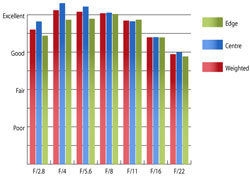 |
| Resolution at 18mm |
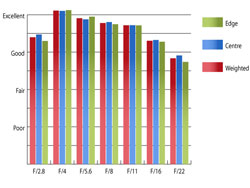 |
| Resolution at 24mm |
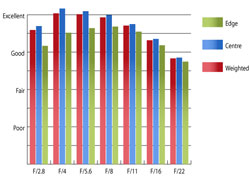 |
Nikon's extensive use of extra-low dispersion glass in the design of this lens has paid dividends when it comes to controlling chromatics aberrations. At its worst, CA covers just over half a pixel-width at 24mm and f/2.8, which will be barely noticeable under normal picture taking conditions. Across the rest of the zoom range, colour fringing is virtually non-existent, with recorded values being well under half a pixel-width. This is exceptional performance for such an extreme range of focal lengths.
| Chromatic Aberrations at 14mm |
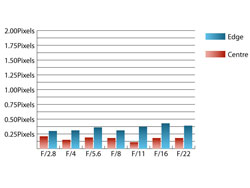 |
| Chromatic Aberrations at 18mm |
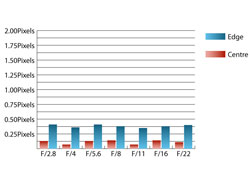 |
| Chromatic Aberrations at 24mm |
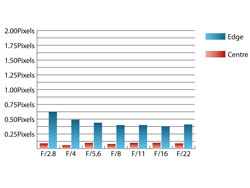 |
On any ultrawide lens, there will be a degree of light falloff towards the edges, especially at wider apertures due to their optical nature. This lens is no exception, with the corners being up to two stops darker than the centre of the image at f/2.8 and 14mm. Stopping down improves matters though with fall off becoming unnoticeable by f/5. Longer focal lengths display much less vignetting, with the corners being under a stop darker than the centre at 24mm and f/2.8. For a lens as wide as this, these results aren't that surprising; in fact I expected them to be a whole lot worse.
 | 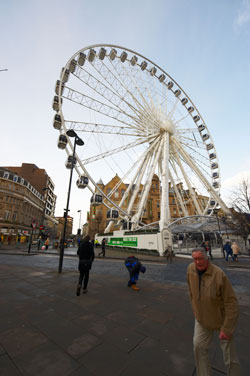 Getting in close can give quirky results as these two shots illustrate. |
Barrel distortion at 14mm is quite strong, but again, not as strong as I expected with 7.37% recorded by Imatest, which could be quite disturbing for fans of straight lines. This can easily be corrected with commonly used lens correction tools such as PTLens or in Photoshop. At 24mm barrel distortion is still present, but only barely, with 0.7% recorded by Imatest.
 |  |
| The ultrawide approach won't suit every photographer, but this lens is capable of amazing results when used well. | |
For a lens with such a large bulbous front element, flare and ghosting is remarkably well controlled. Anyone who has used such a lens before such as a 14mm prime, or a Sigma's 15-30mm will know how much of an issue this can be. With the Nikon AF-S 14-24mm f/2.8G ED , light sources just outside the frame cause a little ghosting, but not the catastrophic reduction in contrast I had expected. Shooting into a light source causes a little flare, but again this is very well controlled for such a lens. Strong light sources in the frame will occasionally produce a small green flare pattern on the opposite side of the image centre, but nothing more.
Nikon AF-S 14-24mm f/2.8G ED NIKKOR: Verdict
This lens is one of a kind. In terms of resolution, handling and even its resistance to flare and ghosting this lens is excellent, and it outperforms primes in the same focal range.
Still, as mentioned before, this lens will not suit everyone. Those who use filters extensively will either have to change the way they shoot, or they won’t find this lens suitable for their needs. This is a shame, as such a focal range lends itself perfectly to landscape shooting. That said, Lee Filters are aiming to have a filter holder available as we reported in News.
Priced at £1296 this is not a cheap lens, but there is more to value than just monetary cost. If you require the absolute best quality and don't use filters, then I believe the high price tag is well worth it for what is a truly unique lens.
| FEATURES |  |
| HANDLING |  |
| PERFORMANCE |  |
| VALUE |  |
| OVERALL |  |
Nikon AF-S 14-24mm f/2.8G ED NIKKOR: Pros
 Optical performance
Optical performance Fast maximum aperture
Fast maximum aperture Handling
HandlingNikon AF-S 14-24mm f/2.8G ED NIKKOR: Cons
 Price
Price Weight
Weight  Filter use difficult
Filter use difficult Nikon AF-S 14-24mm f/2.8G ED NIKKOR: Specification
| Price | £1268 |
| Contact | Nikon UK Ltd |
| Filter size | N/A |
| Format | FX, 35mm |
| Construction | 14 elements in 11 groups |
| Angle-of-view | 114° - 84° (90° - 61° with DX format camera) |
| 35mm equiv. focal length | 14-24mm or 21-36mm on APS-C (DX) body |
| Internal focusing | Yes |
| Image stabilisation | No |
| Minimum focus | 28cm |
| Maximum aperture | f/2.8 |
| Minimum aperture | f/22 |
| Weight | 970g |
| Size | 131.5mmx98mm |
| In the box | Lens case |
The Nikon AF-S 14-24mm f/2.8G ED NIKKOR lens costs around £1295.99 and is available from Warehouse Express here:
Nikon AF-S 14-24mm f/2.8G ED NIKKOR
Add your message
Login required
Please login here or if you've not registered, you can register here. Registering is safe, quick and free.
Please login here or if you've not registered, you can register here. Registering is safe, quick and free.
photodo Stats
1102 lenses
428 MTF tests
74 in-depth photodo reviews
100+ users join each day
Help the lens community by reviewing or rating a lens today via our lens search
428 MTF tests
74 in-depth photodo reviews
100+ users join each day
Help the lens community by reviewing or rating a lens today via our lens search
Latest Lens Reviews
- Chinon 28mm f/2.8 Vintage Lens Review
- Canon EF 70-200mm f/4L IS II USM Lens Review
- Samyang AF 85mm f/1.4 EF Review
- Sigma 70mm f/2.8 DG Macro Art Review
- Samyang AF 24mm f/2.8 FE Review
- Meike 50mm f/1.7 Review
- Tamron 70-210mm f/4 Di VC USD Review
- Lensbaby Burnside 35mm f/2.8 Review
- Asahi Super Takumar 50mm f/1.4 Review
- Asahi Super-Multi-Coated Takumar 135mm f/3.5 Review
